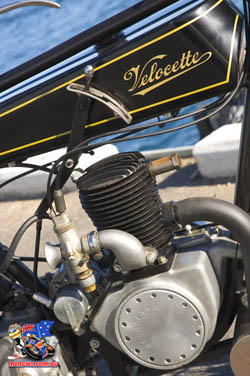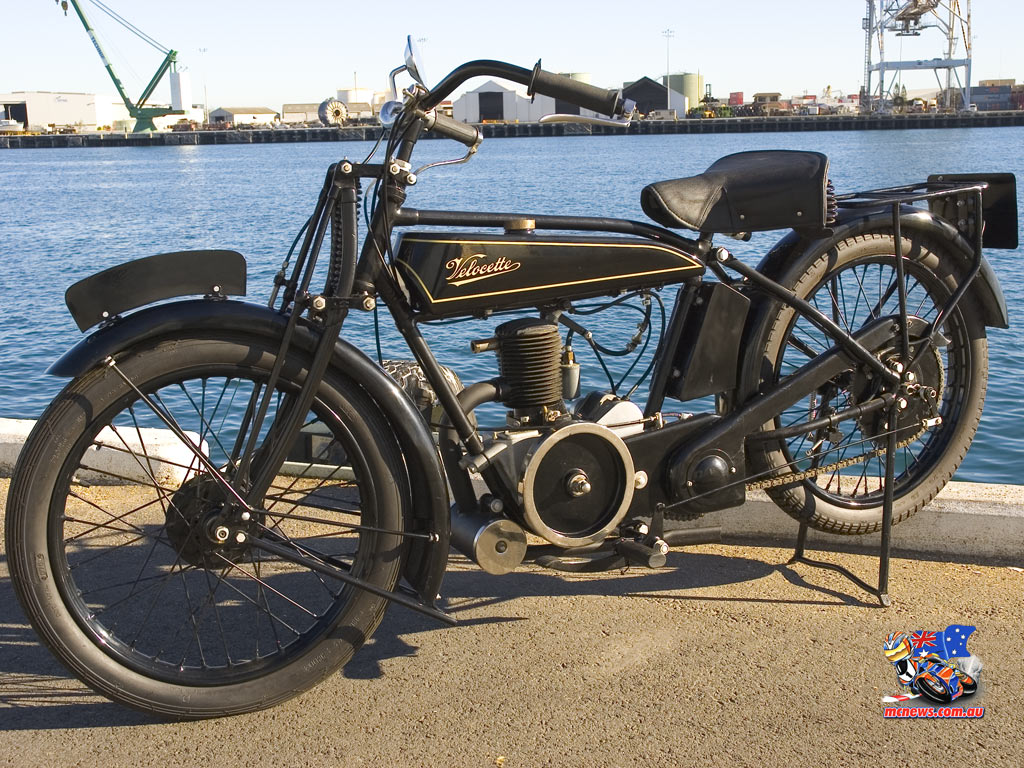Velocette are more widely known for their later Thruxton, Venom and Viper models but previously to these more heralded models the British manufacturer produced a swag of general purpose bikes for your common man.
One of the earlier examples of their craft is showcased at the Fremantle Motor Museum and belongs to Coogee resident Greg Retallack.
 This fully restored machine is a 1923 250cc AC model. Greg has done some research and believes that there are only a couple of other surviving examples of this model, making this beast a rare bird indeed. One that had to be saved from extinction after being rescued from underneath a country WA shearing shed.
This fully restored machine is a 1923 250cc AC model. Greg has done some research and believes that there are only a couple of other surviving examples of this model, making this beast a rare bird indeed. One that had to be saved from extinction after being rescued from underneath a country WA shearing shed.
The machine had belonged to Greg’s grandfather, Leslie ‘Pop’ Keen. Pops, as he was referred to by most, built the first dedicated racing bicycle in Western Australia. Quickly though he moved on to tuning motorcycles and became an expert motorcycle mechanic.
He often prepared machines for racing at the Lake Perkolilli clay pan near Kalgoorlie. These exploits led to a number of motorcycle speed records being achieved after the machines and their riders rode out to Kalgoorlie in the back of a truck with Pops at the wheel. In recognition of his contribution to the racing success of Velocette in Australia, Pops was presented with this 250 AC by the Velocette factory.
After spending some time working at Westcycles he then moved on to form Keens Engineering, operating from the pits at Claremont Speedway. Here he race prepared motorcycle from the 1930s through to the 1960s. He still rode his Velocette on a regular basis until shortly before his death in 1971.
The Velocette was rescued from the farm where it had been used to muster sheep. His grandson Greg then set about restoring the machine to its former glory. He had quite a task ahead of him as when the machine was collected it consisted or only a frame accompanied by two fertilizer bags full of parts. The results clearly show that the efforts were worthwhile.
The machine is powered by a single cylinder 250cc two-stroke engine. The cylinder and head are cast as one piece with the head not able to be removed from the cylinder. A single popper valve is screwed in to the cylinder head to facilitate decompression.
Twist grip throttles were not used back in the 20s, instead the speed was controlled with a bar mounted ignition advance lever and a slide lever, or two, to measure the amount of fuel and air allowed in to the simple carburettor. The original user manual for the machine states that the machine will periodically seize when hot, and that when this happens the rider should simply wait a few minutes for the machine to cool down before kicking it back in to life and carrying on as though nothing had happened…
The modest power is transferred through a three speed manual gearbox with the clutch lever mounted on the left bar. The gear lever is mounted alongside the frame and is shifted by hand. While operating the machine required some masterful hand co-ordination, stopping the machine required brute force. The brakes are activated by the normal method with a foot pedal for the rear and right bar mounted lever for the front. Greg says that you ‘grab both and then pull like crazy’, but also admits that a similar amount of retardation comes from putting your feet down Fred Flintstone style. The machine can manage a tick over 70kph flat out, although it would be a brave man that would test that number today.
Also archaic is the suspension which consists of a sprung seat mounted on a rigid rear, while up front semi-rigid forks are suspended by coil springs.
This machine did originally come with a headlight but that has so far been deemed beyond salvage after being squashed under a tractor. Greg fitted a rear light so the machine can be registered for club events and the battery for this now resides in the frame mounted tool bag. When parked the rider can choose to use either the centre or rear stand which in some ways is better than what we are offered today.
One thing is for sure, this Velocette has definitely seen more adventures in its long life than most and along with ‘Pops’ Keen himself reminds us of what was a heady and ground breaking time for motorcycling in Western Australia.
























